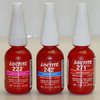Lee Q. Loader
Member
- Joined
- Jan 30, 2018
- Messages
- 444
My old 38 S&W is my favorite gun in my small collection. I hit far better with it than anything I own.
Anyway, when I shoot it the ejector rod comes loose and spins out far enough to make it very difficult to open the cylinder.
I tighten it back up, hand tight, and it does the same thing again.
Any ideas for a permanent fix?
Anyway, when I shoot it the ejector rod comes loose and spins out far enough to make it very difficult to open the cylinder.
I tighten it back up, hand tight, and it does the same thing again.
Any ideas for a permanent fix?


